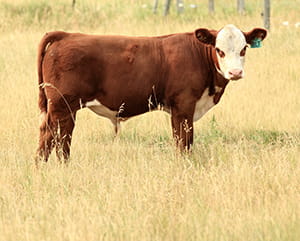By Adriane Good, MSc, AAg, Livestock and Feed Extension Specialist
March 2024
When developing bulls for breeding, fertility is an important factor. Genomics has provided a way for us to measure a bull’s genetic potential without relying on progeny data, making the data on younger sires more reliable. This has already influenced sires that are used for artificial insemination (AI). In the United States dairy industry, the average age of AI sires dropped from 7.1 years in 2009 to 2.5 years in 2015. With genomic data helping to better predict a bull’s performance, it’s important to help bull calves reach their potential as early as possible.

Producers have many opportunities to feed their bulls in a way that maximizes growth and fertility. One of those opportunities starts when the bull calf hits the ground. Colostrum is important for calves to get a good start to life. It provides the base for an animal’s immune system; it is also high in energy and protein for an animal’s first few weeks of life. This boost early on has been shown to increase a bull’s testicular weight at 42 weeks compared to bulls who didn’t receive colostrum as newborns.
Nutrition past the initial intake of colostrum is just as important for a bull’s development. Prior to 24 weeks of age, bull calf diet and growth performance impact the age that they reach puberty, scrotal circumference, paired testes weight, sperm production and testosterone production. These early-life impacts are so important that bulls who miss out on this nutrition will not catch up later. It’s important to note that this can’t be fixed after the fact. Over feeding bulls after they reach puberty can be detrimental as this may lead to fat accumulation in the scrotum, reducing fertility.
Researchers in Calgary compared bull calves that were fed free choice supplement from 10 to 26 weeks of age to bull calves that were restricted to 75 per cent of their intake. On week 27, the bull calves on the free choice diet continued with that diet, whereas the restricted calves were switched to 100 per cent or 130 per cent of their requirements. They found that the calves that ate free choice for the first six months reached puberty earlier and had a higher paired testes weight at 70 weeks of age than those who were restricted and then had their needs met later in life.
Most of a calf’s nutritional needs will be met by their dam. Because of this, cows who produce less milk, like first calf heifers, will produce smaller, later maturing bulls. To ensure all bull calves reach a productive age early and meet their fertility goals, creep feeding can be a great way to maximize their potential. Providing a source of energy and protein will help your bull calves remain on a high plane of nutrition for the first six months of their life to set them up for success after weaning.
For more information on developing bull calves or for assistance designing a creep feeding plan, contact your local livestock and feed extension specialist or the Agriculture Knowledge Centre at 1-866-457-2377.
